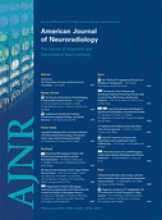Abstract
BACKGROUND AND PURPOSE: Cervical transforaminal blocks are frequently performed to treat cervical radicular pain. These blocks are performed mostly under fluoroscopy, but a CT-guided technique has also been described. The aim of this study was to review the results of CT-guided CSNRB by using a dorsal approach, to describe the contrast patterns achieved with this injection technique, and to estimate the degree of specificity and sensitivity.
MATERIALS AND METHODS: We used a CT-guided technique with a dorsal approach leading to a more extra-than transforaminal but a selective nerve root block as well. Of 53 blocks, we performed 38 for diagnostic and 15 for therapeutic indications. Pain relief was measured hourly on a VAS. The distribution of contrast and the angle of the trajectory of the injection needle were analyzed as well as the degree of pain relief.
RESULTS: Contrast was found in the intraforaminal region in 8 (15%) blocks, extraforaminally in 40 (78%) blocks, and intraspinally in 3 (6%) blocks. The mean angle between the needle and the sagittal plane was 26.6° (range, from 1° to 50°). The mean distance between needle tip and nerve root was 4.43 mm (range, 0–20 mm). Twenty-six (68.4%) of the 38 diagnostic blocks led to a decrease in the pain rating of >50%. There were no complications or unintended side effects, apart from occasional local puncture pain.
CONCLUSIONS: We conclude that CT-guided CSNRBs using a dorsal approach are feasible and that they are sensitive and specific.
Abbreviations
- CSNRB
- cervical selective nerve root block
- VAS
- Visual Analog Scale
- Copyright © American Society of Neuroradiology












